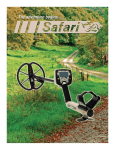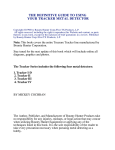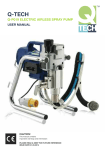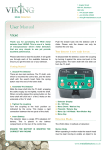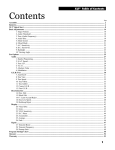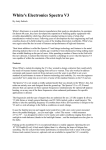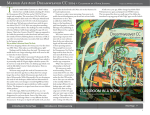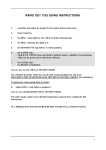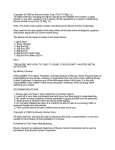Download Whites BeachHunder ID Technical data
Transcript
Detector Field Test White’s DFX XLT Chris Rogers Part One Controls and Settings Clarification of Terminology ithout doubt the biggest problem facing everyone involved in metal detecting is the choice of the best detector for their needs. It is the one topic that seems to lead to more discussion and disagreement in the hobby than any other. Let’s take just one point in isolation from the many that arise in those discussions and, ignoring the cost factor, ask the question “What is better, a simple ‘turn on and go’ detector or an ‘all dancing and singing’ state of the art computerised machine?” Put another way, does the operator benefit from the so-called gadgets on a programmable machine? There is, of course, no definitive answer to this except to say that, in the case of the latter, the majority of user programmable detectors do have the facility to simply switch on and go. This is achieved by using the factory pre-set programmes, which avoid the need to progress further into the finer details of the detector’s operating capability. In my experience very few individuals, once bitten by the detecting bug, drop out and most are soon looking to upgrade their machine to help their efforts in the field. The more that is learnt about the other factors that come into play after gaining some search experience, such as different soil conditions and the varying conductivity of metals, the need for greater flexibility soon becomes apparent. The ability to adjust your machine to these changes can make the programmable detector appear the more desirable option. Whether the individual chooses to progress to these options could depend on his or her available finances. Some years back White’s introduced a new detector onto the market called the XLT. It was a well-balanced, lightweight machine, with easy to use pre-set programmes. It also had seemingly limitless operator adjustments for W the experienced detectorist, coupled with a rugged design and super performance. It is not surprising, therefore, that the XLT came to be one of the most popular and best selling detectors available. During its existence a couple of modifications were introduced, but it remained basically the same machine until last year when the new dual frequency XLT was introduced onto the market, known as the DFX XLT. Having used the XLT for hundreds of hours with great success, I found that a lot of the criticism expressed by the “turn on and go” fraternity was brought about by their failure to read and understand the operator’s handbook, which - to be honest - can appear a bit daunting at first glance. This, when coupled with the retailer who either through lack of knowledge of the machine and/or time, fails to go through the different functions shown on the display screen with the prospective buyer, leads to a lot of the misconception about the XLT and programmable detectors in general. With this in mind I have split my report into two halves. The first part concentrates on the controls and settings while attempting to clarify some of the terminology used. The second part will be the actual field test in which I conducted a number of searches using my own and other recommended settings in a number of different field conditions. My report pre-supposes that the beginner has carried out some research into the basics of detecting and is aware of such terms as “motion” and “non-motion”, “ground minerals”, “discrimination” and “sensitivity”. I have not included a beach test of the DFX but hope to be able to report back on this aspect of the DFX later in the year. Physical Description Immediately on opening the sturdy carrying box the DFX XLT is pleasing to the eye being well constructed and finished. Assembly is straightforward and takes just minutes to complete. As already stated, the owner’s guide can appear complicated especially if you do not take the time and trouble to study it properly. I cannot stress the importance of reading this booklet thoroughly so that you are fully aware of what is available to you and how to go about achieving the best from your detector. The detector’s looks have not changed much from the earlier XLT, but the 9.5in coil is now of the Wide Band Multiple Harmonic type. The LCD meter panel is mounted at the end of a padded handle and under the meter is a toggle switch, operated by the index finger. This can be used for pinpointing and depth screen display. The metal control box, which is fitted below the armrest, has a hinged compartment in which the drop-in battery pack is housed. The detector’s power is supplied from either the re-chargeable type nicad battery (green decal) pack or eight AA dry-cell batteries fitted into the (blue decal) standard battery box. The quarter inch headphone jackplug socket is also fitted in the rear of the control box. March 2002 TREASURE HUNTING 29 FIELD TEST One of the more obvious changes is the logo on the side of the box, which now reads “White’s DFX Spectrum ESeries”. Also printed on the control box is the start-up procedure and a target identification display scale. On the underside is a “Hot Key” shortcut chart that enables easy access from the search mode to the most needed adjustments. Among the less obvious changes are: dual frequency operation, four new user-designed programmes, adjustable sweep speed, and a digital signal filtration system. Set Up The pre-set programmes in the DFX allow the user to push a couple of pads to begin searching while the detector automatically controls the adjustments for you. Beginners will find this facility the best option until they become familiar with the many adjustments that the more accomplished detectorist will want to access. lower coil to ground level. The detector will now be correctly ground balanced and ready for operation in the Coins programme. While the coil is held at waist level the DFX’s circuitry is measuring air temperature and other variables that effect electronic circuits. When lowered to ground level and the Enter pad is pressed again, the DFX is cancelling out the ground mineralisation effect (or ‘Ground Balancing’ the detector). In this and the other four preset programmes no further adjustments are needed. Nevertheless, any number of control adjustments are available to meet almost any need or style of detecting. Display showing Coins programme. Display showing ID number and icon Looking at the display panel you will see five push button control pads. Reading from left to right they are marked: Menu, Arrow (down), Enter, Arrow (up), On/Off. The detector is turned on by pressing the On/Off pad, at which point an automatic battery test is carried out. The screen will momentarily show the battery voltage followed by the main menu. To recheck the voltage, squeeze and hold the trigger while pressing the down arrow. When the battery strength becomes too low for proper function of the detector, the words “Low Bat” will automatically appear on the display. The main menu offers a number of choices commencing with “Preset Programmes”. To access this setting simply press Enter after which a choice of five preset programmes appear on screen with an arrow pointing to the first “Coins”. By pressing Enter (a bleep signal will be heard each time it is pressed) and following the instructions on the screen to raise the search coil to waist level, press Enter again then 30 TREASURE HUNTING March 2002 Display showing SinaGraph (best targets to the right). The last screen to appear will be the search screen, at which point you will also hear the threshold hum. After sweeping the coil across the ground listen for a repeatable solid signal and look at the display. The icon will show what is likely to be below the search head and the VDI (Visual Display Identification) number can be checked against the chart on the control box. The SignaGraph section of the screen provides even greater information. Because this is a motion type detector the search coil must be kept moving to respond to a target. (See Mixed Mode). Other Menu Options We have already covered the first option on the VDU, Preset Programmes. The other options are: Basic Adjustments, Pro Options, and Custom or EEPROM programmes. Within these headings there are a number of settings, such as RACHET PINPOINT, COARSE GEB, PREAMP GAIN and many others that may not be familiar to users of different makes of detectors. With more than a little help from the manual, I will try to explain in detail what these terms mean. EEPROM stands for Electrical Erasable Programmable Read-Only Memory, which is a memory chip that allows the storage of up to four custom programs despite battery changes and years of storage. These four “memory slots”, along with the five Preset Programs, add up to a total of nine programs that should fit just about everyone’s needs. The four EEPROM programmes can be erased and replaced with your own custom programmes. Setting them is a simple operation and I will cover this in the field test part of this report. The first five Preset Programs are in permanent memory, with a similar looking name of EPROM (notice that one E is missing for Erasable). Changes made in these programs will return to factory settings when you change from one program to another or change batteries. However, if you have made changes and forget to save them in a custom program before turning off the machine, all is not lost. With a good battery still intact, squeeze and release the trigger immediately upon turning the detector back on, and the circuitry will revert to the last settings used. Otherwise, settings will revert to factory preset. Preset Programs The following is an explanation of each Preset Program. Coins - All controls are set to handle rubbish contaminated areas such as parks, responding to most coins and larger jewellery. Discrimination is high in order to eliminate signals from items like nails, foil, ring-pulls, and “hot rocks”. If possible, though, try to start with a program of low discrimination, as good items can be missed along with the bad. This is true for all metal detectors due to various reasons such as the conductive properties of different metals. This program will save you a lot of digging in badly contaminated areas. Coins and Jewellery - This is similar to the Coins program but with less discrimination. This means you will receive a few more dubious signals but it is recommended when searching areas where there is less rubbish. Jewellery and Beach - Much like the above, but with settings enhanced to keep the false signals of salt water from spoiling your searching. Use this one on the beach where gold jewellery can appear anywhere on the display from iron through to the silver range due to the amount of debasing that has been used, as well as the length of time the object has been buried, size, etc. Relic - Here the discrimination is really low to permit the acceptance of all metals except small iron targets such as nails and some stainless steel. It separates ferrous/non-ferrous by display indications. However, large pieces of iron such as nails, horseshoes, broken ploughshares and other fragments will give a positive signal. Prospecting - This is a good program if you are looking for gold. All metals will give an audio signal, but the only ones to give a VDI (number reading) are likely to be gold. I personally wouldn’t use this programme much in this country. Basic Adjustments Target Volume - Adjusts for the loudness of the target signal. Some people believe that setting this very high will bring greater depth, but this isn’t necessarily true. Always use a setting that doesn’t cause any discomfort. Audio Threshold - This is the continuous background hum. Set it to a just audible level that is right for your hearing. Again, lots of old hands will tell you to have a high threshold setting for deeper targets - don’t believe them. Tone (Audio Frequency) - Quite simply this means pitch of signal. Set it at a pitch that matches your hearing. I found the higher range best for my hearing. Audio Discrimination - Use the OFF position to detect all types of metals. ON rejects rubbish with different sounds for different types of targets. Trash goes silent or gives a clipped sound, while better targets produce a solid sound. Silent Search - I prefer to have a very low threshold level but for those people who prefer no background noise this facility will suit them. Others, of course, like to hear the background hum, to listen for subtle changes in audio such as the threshold fading over rejected targets, and changes in ground conditions. As you might expect, AUDIO DISC is ON, and MIXED MODE is OFF, during SILENT SEARCH. Mixed Mode - This means two modes of operation at once with the ALL-METAL NON MOTION and the MOTION DISCRIMINATE mode both working together - one accepting everything and the other discriminating rejected targets. For the advanced user adding TONE ID and/or VCO will lead to better results. SILENT SEARCH needs to be OFF and AUDIO DISC ON. Discrimination settings will give a high or low pitch signal while the All Metal mode will give all targets a low-pitched signal. Together with Motion Discriminate and All Metal Non-Motion, Mixed Mode provides a third type of operation. Discriminate requires coil motion, All Metal does not. A.C. Sensitivity - Sets sensitivity for the motion discriminate mode. Along with DC SENSITIVITY and PREAMP GAIN, this control determines how deep the detector will search. It should be set as high as possible without causing the detector’s circuits to become unstable and give false signals (chatter). Experiment with the ground conditions, adjusting this control and the Preamp Gain to achieve the greatest depth possible. D.C. Sensitivity - Sets sensitivity for the ALL METAL NON-MOTION mode for stability and pinpointing. Shallow targets pinpoint better with a lower setting. MIXED MODE and VCO AUDIO are also affected by the D.C. Sensitivity setting. Backlight - The use of the backlight can be quite a drain on the battery, and this control allows you to use as little power as possible. In an improvement over past Spectrum detectors, the DFX stores the setting in the custom programs. The backlight is used for searching in poor light. In an emergency hold the trigger and press MENU to turn it on. Viewing Angle - This is a control that adjusts the visibility of the display for various temperatures. The higher numbers speed up the display to improve visibility in cooler temperatures, while lower numbers work when detecting in warmer conditions and in strong sunlight. Again, the settings can be saved in the custom programs. Pro Options I spent a lot of time messing around with these options and found that it pays to experiment. More details will be given about this in the actual field test. Pro Options Sub Menu #1 Ratchet Pinpointing - Pinpointing has always been a very personal operation, although a detector’s ability to pinpoint a target varies greatly between makes. How many times have you heard people say that they can’t pinpoint well? This control does the detuning process automatically. The previous need to release and then resqueeze the pinpointing trigger as the centre of the coil approaches the centre of the target is now done by the detector, reducing the virtual size of the target. Think carefully before using this facility as some people prefer to judge the size of the target before detuning. S.A.T. Speed - This is an abbreviation for Self Adjusting Threshold, otherwise known as auto-tune. It keeps the threshold hum even, which is especially important when hunting in the All Metal mode or when Sensitivity is high. Generally, faster speeds are for more mineralised ground, and slower speeds for less mineralised ground. Without this control the Threshold would drift due to ground changes, and the trigger would have to be continually re-squeezed. In relation to types of hunting, slower speeds are for coin hunting, higher speeds are for beach and relic hunting, and the fastest are for prospecting. Tone I.D. - Allows each V.D.I. (target ID) number to have its own tone. The higher the V.D.I., the higher the pitch. There are 191 different pitches used in the MOTION DISCRIMINATION mode. TONE I.D. comes into its own when using the MIXED MODE. V.C.O. - Stands for Voltage Controlled Oscillator, and that means the stronger the target signal, the higher the tone pitch. This feature is used in the non-discriminate modes to aid in pinpointing as well as helping in March 2002 TREASURE HUNTING 31 FIELD TEST MIXED MODE. The D.C. SENSITIVITY setting has a direct effect on V.C.O. In pinpointing, when you hear that pitch at its highest, you know you are over the centre of a target. Modulation - This control determines whether the motion mode gives a strong signal on deep targets, or a soft one. ON gives lower volume deep responses; OFF supplies the same volume regardless of how deep the target lies. When experiencing faint signals, which could mean deep targets and possibly older finds, this control may be of help, Autotrac - Automatically keeps the ground balance setting adjusted while you hunt. The importance of precise ground balance cannot be over emphasised. The only time you would want to turn this OFF is if you are over a lot of rusting, man-made iron. Be aware that TRAC INHIBIT affects AUTOTRAC. Trac View - The word TRACK appears on the display when AUTOTRAC adjusts the ground balance. Preset to OFF, it should really be kept ON to be certain that you have the correct TRAC SPEED setting. When TRACK appears often on the display, it could also mean bad ground mineralisation. Trac Speed - Determines how often AUTOTRAC regulates the ground balance, by setting how much change in mineralisation is needed to cause an adjustment. Slower speeds equal great change; faster speeds equal minor change. Excessive tracking can cause ground balance errors, and too little does not keep up with changing ground. When TRACK is seen appearing every three to five coil sweeps, the TRAC SPEED is correct. Trac Offset - This feature is intended to be used by experienced searchers to track mineralisation either of the extra negative or positive type. Small metal targets such as gold nuggets in heavy mineralisation would benefit from a slightly positive setting, while a slightly negative setting can help reduce “hot rock” signals. Trac Inhibit - Use OFF for prospecting and ON for most other detecting situations. It prevents Autotrac from tracking the ground while the target is detected. ON reduces the tracking to corrosion of most metals. Since gold does not corrode, OFF is automatic in the PROSPECTING Program. 32 TREASURE HUNTING March 2002 Recovery Speed - This is the time it takes your detector to recover from the last target before it can respond to the next. Faster speeds work best for trashy areas. Use slower speeds for cleaner areas and better discrimination. The faster speeds are also good for separating closely spaced targets, but you will reach a speed where depth and the sounds of discrimination begin to suffer. A speed just below this seems to work the best. Drop in rechargeable battery pack. Coarse G.E.B. & Fine G.E.B. This is for manual ground balancing. Those who opt for manual ground balance over the exceptionally good automatic ground balance already know what they are doing. With 255 settings, COARSE is for large adjustments, while FINE is for small ones. There are times when manual ground balance can be useful, but the large majority of users will choose the DFX’s automatic ground balance. Disc. Edit - Permits setting each V.D.I. Number to be accepted or rejected by the discrimination with no apparent loss of depth while using discrimination. Be aware, though, that the more V.D.I. numbers are rejected, the greater the possibility of rejecting good targets. The best advice is to keep discrimination as low as possible, thus accepting the widest range. V.D.I. numbers (Target ID) can be accepted or rejected from -95 to +95. While +95 is often associated with a “hot rock”, it is best to dig if it indicates a deep target on the display. Block Edit - Allows the user to change the accepting or rejecting of larger groups of V.D.I. numbers by dragging ACCEPT or REJECT, using the ARROW controls. Learn Accept/Reject - This feature is useful when your program is all set and working well, but you keep encountering one specific type of trash. Select LEARN REJECT and sweep the coil over that junk until the signal disappears. On the other hand, if you were hunting for one specific item - say, a lost earring - you could reject everything, and then LEARN ACCEPT that one signal by running the other earring under the coil. Don’t forget to turn LEARN off, or the detector will be learning to reject or accept everything the coil passes over. Bottlecap Reject - Sets how well the detector rejects iron. A higher number causes more broken sounds on iron targets and thus makes them easier to identify. Set it too high, though, and good targets will start to sound bad also, and iron next to a good target will lose both. Start at preset and experiment from there in the area being hunted. Hot Rock Reject - Determines the responses to those rocks with a different mineralisation than the surrounding soil. A +95 V.D.I. reading is often a hot rock, but it can also be a deep good target, as noted earlier. This control allows a range of rejection or acceptance of this V.D.I. number. Instead of just accepting or rejecting +95, one can run a range from 0 to 20. Zero accepts +95 while 20 rejects it. This control provides many areas in between to help give the hot rocks a different sound than real targets. A negative hot rock is also called a “cold rock”, and the response will disappear in pinpoint. A positive hot rock will continue to respond in pinpoint mode. This control could be invaluable in an area with similar hot rocks. Sweep Speed - If you need to move quickly, a higher speed is indicated. Conversely, if you need to slow down, a slower coil movement is needed. Faster speeds could be effective in a competition hunt or when you want to cover ground where targets are fewer. Hightrash areas will cause you to slow down, so a slower sweep speed is best at those sites, or anywhere you need to do a slow search. Sweep speed is more important than the casual detectorist would think, so a little more time has to be spent here. Sweep Speed is related to Recovery Speed and Ground Filtering, and that relates to depth and discrimination. Basically, a faster sweep goes with faster Recovery speeds, and vice versa. Some people like to swing the coil fast, and some slow, never realising that speed affects the depth and discrimination ability of the detector. A Chris Rogers nice feature on the DFX is this ability to set your own speed. I also mentioned GROUND FILTERING, and we will get to that in the next section. However, you need to know that the sweep speed of the DFX is not adjustable when using two filters, as the detector does that for you. On the other hand, when using three to six ground filters, you can set the speed yourself if desired. Too fast a Sweep Speed and it will get ahead of the Recovery Speed, but you don’t want it too slow either. It’s a matter of choosing the right width of target signal that the circuitry analyses. You want a Ground Filter, Recovery, and Sweep Speed that will give you the best depth and discrimination. A bit of experimenting will reveal the ideal speed for your preference and type of hunting. If you don’t have a test area already, bury a few coins away from each other in clean ground and at various depths. Make all your settings and then try various sweep speeds to see which provides the best performance. At this stage it is good to remember, that all these things are for people who want to tweak up the DFX’s performance. If you are new to the hobby, don’t get mind boggled. Just let the detector do the work in the Preset Programs. Ground Filtering - As stated earlier, the DFX offers a choice of up to six filters! What does that mean? Well, it means versatility. It means that you can use the same machine for both coinshooting in parks and relic hunting in extreme ground. The two filters will provide a quicker response to separate closely spaced targets in a trashy area, while the four, five and six filters will better handle mineralisation - and that means more depth. White’s use this number system to let you know that as the level of mineralisation goes up, the depth penetration goes down with the lower number of ground filters being used. Visual Disc - When this feature is on, rejected VDI numbers and ICONS are prevented from appearing on the display. This keeps the display cleaner for interpreting other information. Icons - The ability to look at the display to see the graphic representation for a ring pull, nail, screw cap, foil, or various coins is good. It can speed things along as you walk. However, it does slow down the display for other indications, which in turn slows down how soon you go to the next target. V.D.I. Sensitivity - This determines the strength of response of a target required to cause a display indication. It can also provide a third digit to the VDI number when set to 86 or above. A lower setting brings fewer and more reliable indications to the display, but may also keep deeper targets from registering. A higher setting brings more indications to interpret. Try listening to signals first, and then look at the display to isolate a good target. D.C. Phase - Those people who set their own manual ground balance will find this of use. When the coil is stopped over a target or ground, the D.C. PHASE is shown in the display. Accumulate, Average, & Fade These three controls are listed together for convenience. With ACCUMULATE turned ON, SignaGraph information is gathered from multiple coil passes. OFF shows information only from the last coil sweep. AVERAGE is best used with ACCUMULATE to reduce indications from strange loop or target angles. AVERAGE does what it says, it “averages” received information for the SignaGraph. FADE is the rate at which old information is cleared from the SignaGraph. With up to 14 settings, you can easily choose one that allows enough time to view the SignaGraph info before it is reset. Preamp Gain - This was commonly known as “signal balance” on older machines. It is very important to the depth capability of the detector. Like Sensitivity, it needs to be set as high as possible without causing circuit instability. Unlike Sensitivity, however, it has a great influence on OVERLOAD. Overload should not be appearing in the display during searching. White’s limit the PREAMP GAIN settings from 1 to 4. Get it as high as possible without OVERLOAD. One thing to remember is that every time PREAMP GAIN is changed, the detector needs to be reground balanced. Multi Frequency Method - The DFX provides four choices in operating frequencies: two Frequency Best Data, two Frequency Correlate, one Frequency 3kHz, or one Frequency 15kHz. Only one of these can run at a time. The DFX is offering a choice of frequency settings and not limiting you to what the manufacturer provides. No one choice is best for everything. Gold responds better at higher frequencies, while silver and copper respond better at lower frequencies. The 3kHz option is great for high iron content black sand when salt is not present, and gives better depth on higher conductivity metals like silver. The 15kHz works well in lower mineralisation without salt for gold and cupronickel range targets. Multi Frequency operation does a great job in areas with magnetic iron and conductive salt. The term “BEST DATA” can be misleading as one of the two choices in multi frequency. It suggests that it is the “best” method to use, and while that is often true, it is not always the case. CORRELATE compares data taken from both the 3kHz and 15kHz and rejects those that do not offer predictable information. For instance, iron does not compare predictably between the two frequencies, and thus this method would provide good iron rejection. The BEST DATA multi-frequency method transmits and processes data at both frequencies just as Correlate does, but then automatically chooses to accept the data from the most reliable. Both multi-frequency methods eliminate salt signals. BEST DATA is the preferred method for most applications. V.D.I. Normalisation - Using two frequencies changes where targets show up on the normal VDI scale. The DFX is automatically set up to account for this when using one of the multifrequency methods. But when using one of the single-frequency methods, the calibration is different. With NORMALISATION ON, the circuitry recalculates and displays the normal V.D.I.s we are all used to seeing with the 6.59kHz. When OFF, the display becomes distorted in that the “Silver” end is expanded and the lower end compressed when using 3kHz, while just the opposite happens with 15kHz. This expanded resolution presents a bonus when seeking specific targets for example, looking in the “nickel-foil” range for differences between gold jewellery and aluminium. As previously stated, please don’t get hung up with all of the foregoing. The purpose of going through the individual details of the DFX was simply to take some of the mystery out of the settings available as well as to show the potential of the detector. Having gone through all of the technical data, there’s nothing like using a detector for the real answers and I have tried to do this in the second half of the report. Just as a taster, after experimenting with some of the adjustments, I found 127 non-ferrous finds in just four hours TH detecting! March 2002 TREASURE HUNTING 33





